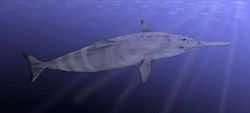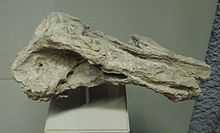Squalodon
| Squalodon Temporal range: Early Oligocene–Middle Miocene | |
|---|---|
 | |
| Skull in Brussels | |
| Scientific classification | |
| Kingdom: | Animalia |
| Phylum: | Chordata |
| Class: | Mammalia |
| Order: | Cetacea |
| Superfamily: | Platanistoidea |
| Family: | †Squalodontidae Brandt, 1873 |
| Genus: | †Squalodon Grateloup, 1840 |
Squalodon is an extinct genus of whales, belonging to the family Squalodontidae. Named by Jean-Pierre Sylvestre de Grateloup in 1840,[1] it was originally believed to be an iguanodontid dinosaur but has since been reclassified. The name Squalodon comes from Squalus, a genus of shark. As a result its name means "shark tooth."
Description

Squalodontids are odontocetes that lived during the early-middle Oligocene into the middle Miocene, about 33 to 14 million years ago. The genus Squalodon belongs to the order Odontoceti, the toothed whales (Kowinsky, J.). They are named after the shark Squalus because their cheek teeth look like the teeth of a squalus shark. The unique-looking squalodontids were likely distributed throughout the world in warm waters during the Oligocene and Miocene. Squalodontidae went extinct in the middle of the Miocene, leaving no descendants. Hypotheses of why this family lead to extinction have to deal with competition of other groups of dolphins as well as climate change (Fordyce, R.E).
Ancestral and modern features

These whales are characterized by both ancestral and modern features. Their teeth are the most evident ancestral feature. At this time in history other toothed whales were evolving simple conical teeth while Squalodontidae retained their primitive dentition that their ancestors (the archaeocetes) had developed (Fordyce, R.E.). Today living odontocetes have little variation in their teeth. Squalodontids' teeth are much more complex: they are widely spaced apart; their cheek teeth are triangular and serrated for grasping and cutting. Due to the efficiency of their primitive dentition squalodontids could have a diverse variety of prey (Fordyce, R.E.),(Kowinsky, J.). Another ancestral quality of the Squalodontidae is their necks. Squalodontid necks are more compressed than their ancestors, the Archaeoceti. Compared to toothed whales at that time, the squalodontids were likely more mobile. Paleontologists also believe that the dorsal fins were reduced but larger than that of the ancestors (Kowinsky, J.). Shark toothed whales also possess many modern features. Their crania were well compressed, their rostrums were telescoped outward, and their skulls show proof of the origin of echolocation. (Kowinsky, J.)
Fossil record and classification

One of the first fossils described in scientific literature is that of a specimen of Squalodon (Fordyce, R.E.). Fossils of this genus are identified mainly by the teeth but several different species have been named based on skull characteristics and size (the biggest being S. whitmorei). Most of the fossil record consists of teeth. These odontocete fossils have been discovered in Europe, eastern North America, New Zealand, and Argentina. Because isolated teeth are insufficient for species identification, most specimens lacking the skull can only be identified to genus (Dooley,A.). The fossils of squalodontids indicate that this species is more closely related to endangered species of dolphins and not to most of the living dolphins today (Fordyce, R.E.). The classification of this genus is not clear. A book by Charles Darwin states that "....Squalodon, which have been placed by some naturalists in an order by themselves, are considered......to be undoubtedly cetaceans..." (Darwin, C.) Many of the fresh-water dolphins are differentiated phylogenetically very well, while the argument of some of the species has been going on for more than a century. The taxon is characterized during the Oligocene and Miocene in which heterodont teeth are standard amongst the family. Some modern features of the scapula, however, contradict with current phylogenetic relationships. Squalodontids were believed to be the last common ancestor of the odontocetes until 1984. Muizon came to the conclusion that rather than to any of the living species this family is closer related to the endangered species. Therefore, the ancestry of today's dolphins has little to do with the squalodontids (Fordyce, R.E.).
See also
References
- ↑ Grateloup, Description d'un fragment de mâchoire fossile, d'un genre nouveau de reptile (Saurien), de taille gigantesque, voisin de l'Iguanodon..., Bordeaux 1840.
- Kowinsky, J.
- Fordyce, R.E.
- Dooley, A.
- Darwin, C.
External links
- Squalodon Facts and Information: Fossilguy.com
- Tree of Life
- Otago University
- Calvert Marine Museum
- The Free Dictionary
- Shark-toothed dolphins (Family Squalodontidae)
- Family †Squalodontidae - Hierarchy - The Taxonomicon